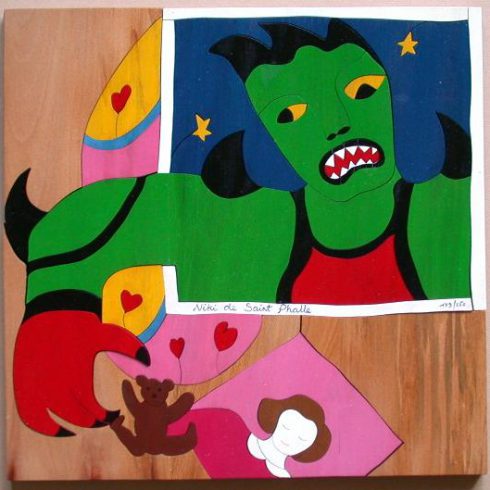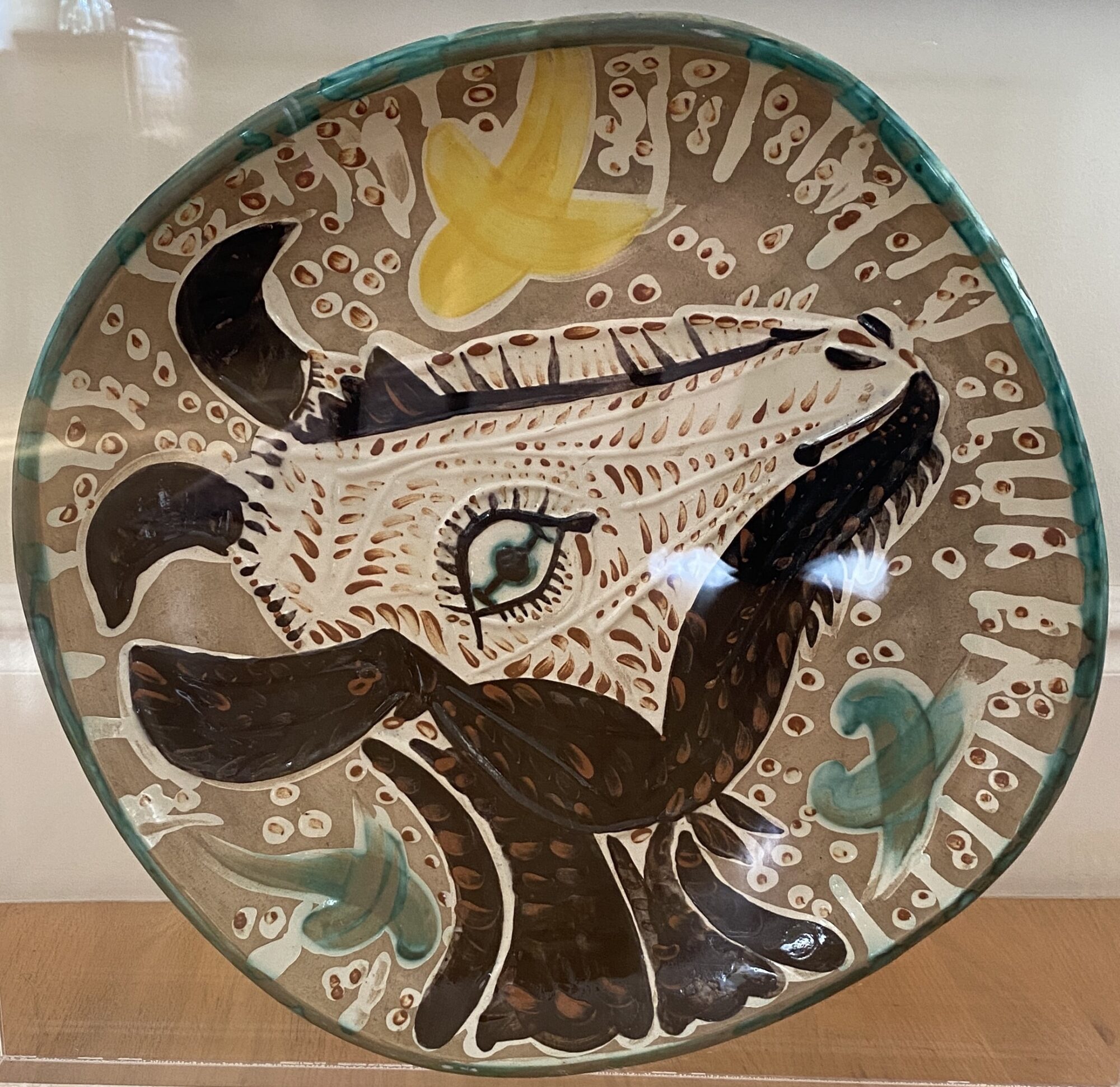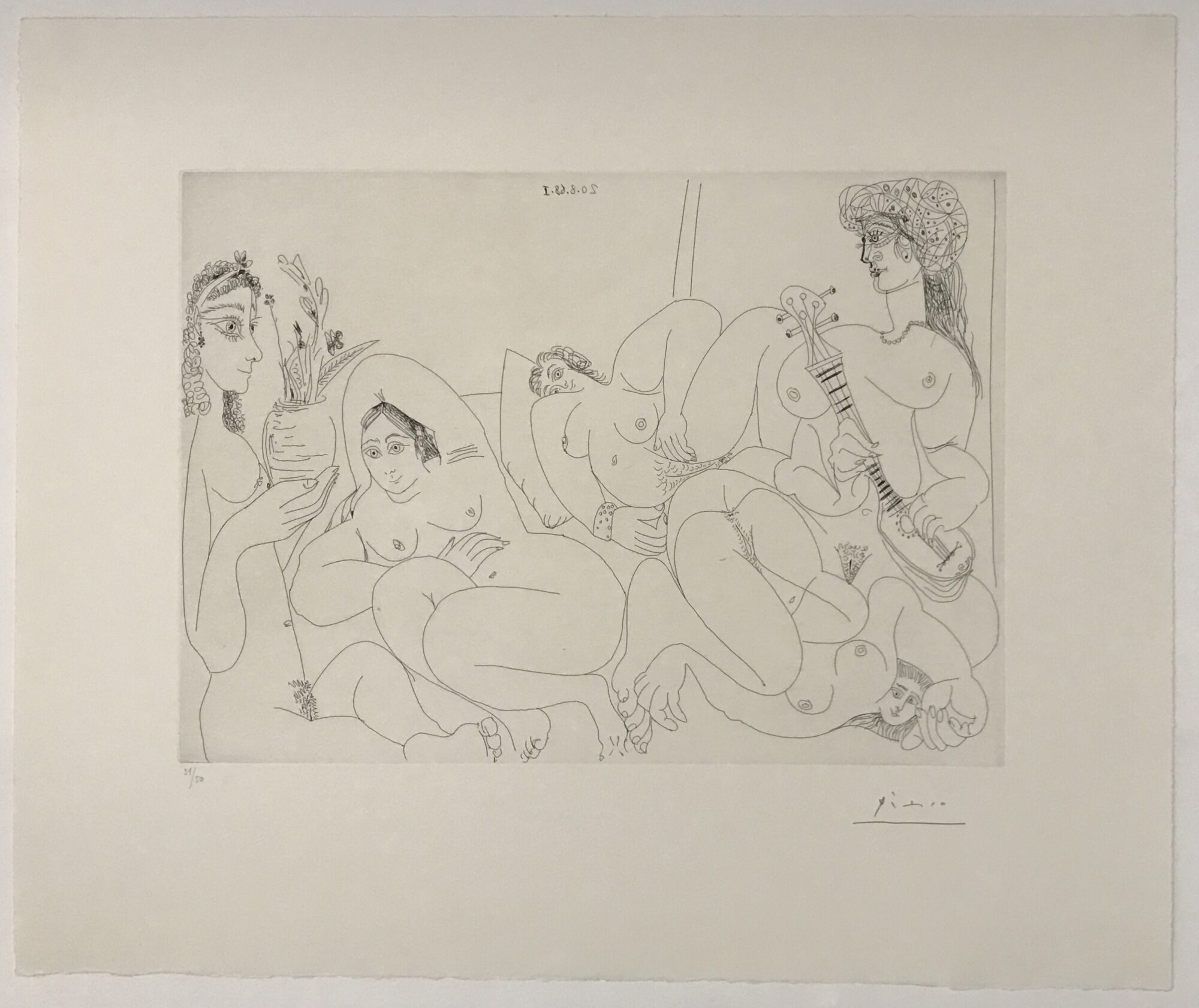Pablo Picasso Three Sardines Ceramic
Pablo Picasso Three Sardines Ceramic is an original rectangular ceramic platter, made of white earthenware clay, partially glazed and painted in brown, blue, and tan. From the edition of 200. Inscribed Madoura/Edition Picasso on verso. AR 34.
A prolific and tireless innovator of art forms, Pablo Picasso impacted the course of 20th-century art with unparalleled magnitude. Inspired by African and Iberian art and developments in the world around him, Picasso contributed significantly to a number of artistic movements, notably Cubism, Surrealism, Neoclassicism, and Expressionism. Along with Georges Braque, Picasso is best known for pioneering Cubism in an attempt to reconcile three-dimensional space with the two-dimensional picture plane, once asking, “Are we to paint what’s on the face, what’s inside the face, or what’s behind it?” Responding to the Spanish Civil War, he painted his most famous work, Guernica (1937), whose violent images of anguished figures rendered in grisaille made it a definitive work of anti-war art. “Painting is not made to decorate apartments,” he said. “It’s an offensive and defensive weapon against the enemy.” Picasso’s sizable oeuvre includes over 20,000 paintings, prints, drawings, sculptures, ceramics, theater sets, and costume designs.
| Title | Three Sardines |
|---|---|
| Alt. Title | Trois Sardines |
| Medium | Ceramic |
| Year | 1948 |
| Edition | 200 |
| Catalogue Raisonné | Ramier 34 |
| Signature | Signed |
| Size | 12.5 x 15.25 (in) 32 x 39 (cm) |
| Price | SOLD |
Description
Pablo Picasso Three Sardines Ceramic is an original rectangular ceramic platter, made of white earthenware clay, partially glazed and painted in brown, blue, and tan. From the edition of 200. Inscribed Madoura/Edition Picasso on verso. AR 34.
Pablo Picasso Three Sardines Ceramic
A prolific and tireless innovator of art forms, Pablo Picasso impacted the course of 20th-century art with unparalleled magnitude. Inspired by African and Iberian art and developments in the world around him, Picasso contributed significantly to a number of artistic movements, notably Cubism, Surrealism, Neoclassicism, and Expressionism.
Pablo Picasso Three Sardines Ceramic
Along with Georges Braque, Picasso is best known for pioneering Cubism in an attempt to reconcile three-dimensional space with the two-dimensional picture plane, once asking, “Are we to paint what’s on the face, what’s inside the face, or what’s behind it?”
Pablo Picasso Three Sardines Ceramic
Responding to the Spanish Civil War, he painted his most famous work, Guernica (1937), whose violent images of anguished figures rendered in grisaille made it a definitive work of anti-war art. “Painting is not made to decorate apartments,” he said. “It’s an offensive and defensive weapon against the enemy.” Picasso’s sizable oeuvre includes over 20,000 paintings, prints, drawings, sculptures, ceramics, theater sets, and costume designs.
Pablo Picasso Three Sardines Ceramic
Pablo Picasso was one of the most influential artists of the 20th century. His ingenious use of form, color, and perspective profoundly impacted later generations of painters, including Willem de Kooning and David Hockney. “There are artists who transform the sun into a yellow spot, but there are others who, thanks to their art and intelligence, transform a yellow spot into the sun,” he once said. Born Pablo Diego José Francisco de Paula Juan Nepomuceno Crispín Crispiniano María de los Remedios de la Santísima Trinidad Ruiz Picasso on October 25, 1881 in Málaga, Spain, his prodigious talent was cultivated early on by his father the painter Jose Ruíz Blasco. Picasso went on to attend the Royal Academy of San Fernando in Madrid, and lived for a time in Barcelona before settling in Paris in 1904.
Pablo Picasso Three Sardines Ceramic
Immersed in the avant-garde circles of Gertrude Stein, he rapidly transitioned from Neo-Impressionism through the Blue Period and Rose Period, before reaching a culmination in his masterpiece Les Demoiselles d’Avignon (1907). Constantly in search of pictorial solutions and in dialogue with his friend Georges Braque, Picasso melded forms he saw in African sculpture with the multiple perspectives he gleaned from Paul Cézanne, to produce Cubism. Not limited to painting, the artist also expressed himself through collage, sculpture, and ceramics. Having been deeply affected by the ongoing Spanish Civil War, Picasso created what is arguably his most overtly political work Guernica (1937), a mural-sized painting depicting carnage with jagged shapes and contrasting grayscale. The artist was prolific up until his death on April 8, 1973 in Mougins, France. Today, his works are held in the collections of The Museum of Modern Art in New York, the Tate Gallery in London, the Hermitage Museum in St. Petersburg, as well as institutions devoted solely to his life work, such as the Museo Picasso Málaga, the Museu Picasso in Barcelona, and the Musée National Picasso in Paris.
Pablo Picasso Three Sardines Ceramic
Additional information
| Title | Three Sardines |
|---|---|
| Alt. Title | Trois Sardines |
| Medium | Ceramic |
| Year | 1948 |
| Edition | 200 |
| Catalogue Raisonné | Ramier 34 |
| Signature | Signed |
| Size | 12.5 x 15.25 (in) 32 x 39 (cm) |
| Price | SOLD |










